GEEKOM A5 mini-PC Review: Affordable Cezanne Zen 3 at 35W
by Ganesh T S on December 8, 2023 9:15 AM ESTSystem Performance: Multi-Tasking
One of the key drivers of advancements in computing systems is multi-tasking. On mobile devices, this is quite lightweight - cases such as background email checks while the user is playing a mobile game are quite common. Towards optimizing user experience in those types of scenarios, mobile SoC manufacturers started integrating heterogenous CPU cores - some with high performance for demanding workloads, while others were frugal in terms of both power consumption / die area and performance. This trend is now slowly making its way into the desktop PC space.
Multi-tasking in typical PC usage is much more demanding compared to phones and tablets. Desktop OSes allow users to launch and utilize a large number of demanding programs simultaneously. Responsiveness is dictated largely by the OS scheduler allowing different tasks to move to the background. The processor is required to work closely with the OS thread scheduler to optimize performance in these cases. Keeping these aspects in mind, the evaluation of multi-tasking performance is an interesting subject to tackle.
We have augmented our systems benchmarking suite to quantitatively analyze the multi-tasking performance of various platforms. The evaluation involves triggering a ffmpeg transcoding task to transform 1716 3840x1714 frames encoded as a 24fps AVC video (Blender Project's 'Tears of Steel' 4K version) into a 1080p HEVC version in a loop. The transcoding rate is monitored continuously. One complete transcoding pass is allowed to complete before starting the first multi-tasking workload - the PCMark 10 Extended bench suite. A comparative view of the PCMark 10 scores for various scenarios is presented in the graphs below. Also available for concurrent viewing are scores in the normal case where the benchmark was processed without any concurrent load, and a graph presenting the loss in performance.
| UL PCMark 10 Load Testing - Digital Content Creation Scores | |||

| UL PCMark 10 Load Testing - Productivity Scores | |||
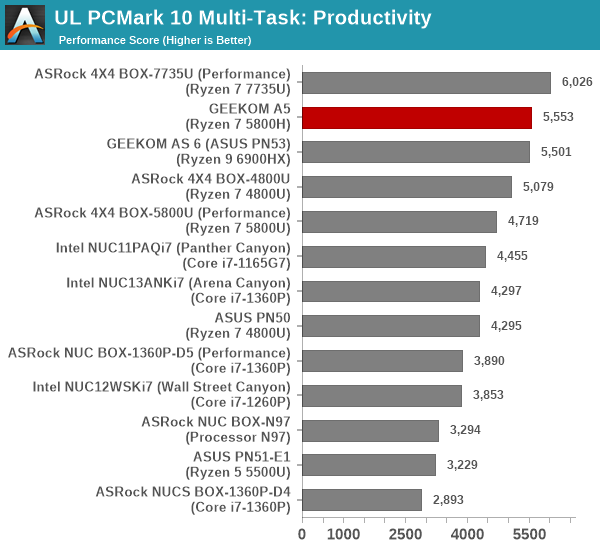
| UL PCMark 10 Load Testing - Essentials Scores | |||
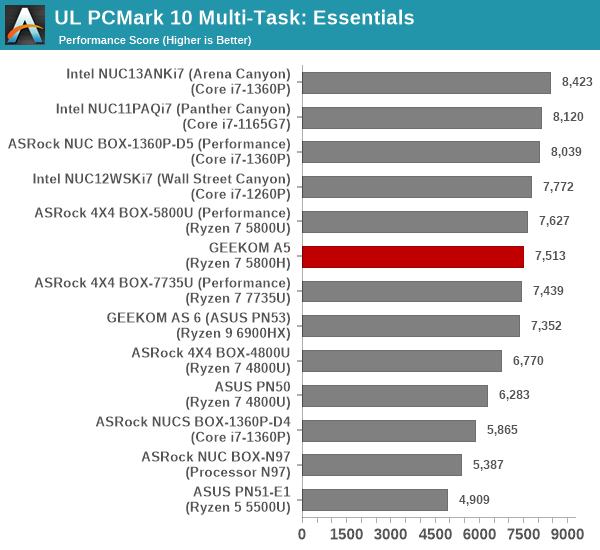
| UL PCMark 10 Load Testing - Gaming Scores | |||
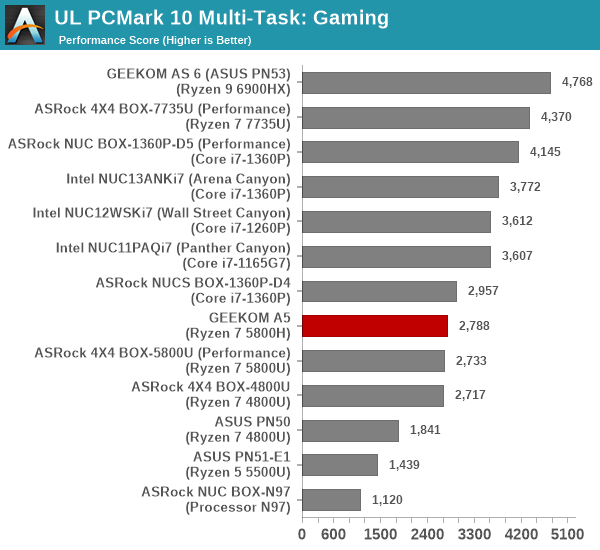
| UL PCMark 10 Load Testing - Overall Scores | |||
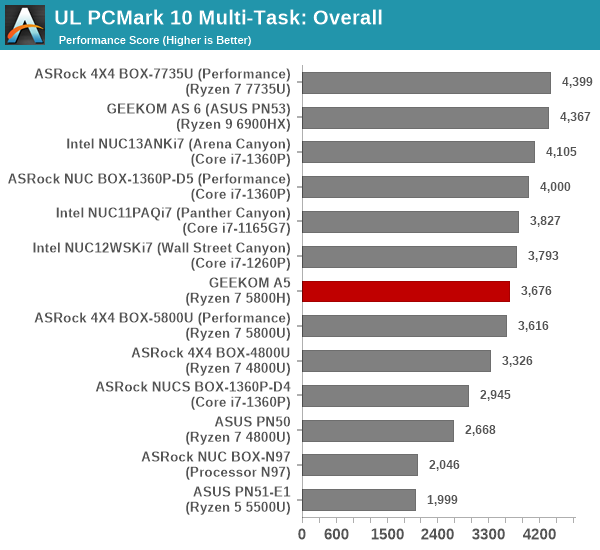
The addition of concurrent loading obviously reduces the PCMark 10 scores. The A5 doesn't lose out too much on the performance front despite the lack of a 'thread director' mechanism. This is due to the additional number of high-performance cores compared to the equivalent-generation Alder Lake-P processor. Other than that, the relative ordering across different processor generations is maintained.
Following the completion of the PCMark 10 benchmark, a short delay is introduced prior to the processing of Principled Technologies WebXPRT4 on MS Edge. Similar to the PCMark 10 results presentation, the graph below show the scores recorded with the transcoding load active. Available for comparison are the dedicated CPU power scores and a measure of the performance loss.
| Principled Technologies WebXPRT4 Load Testing Scores (MS Edge) | |||
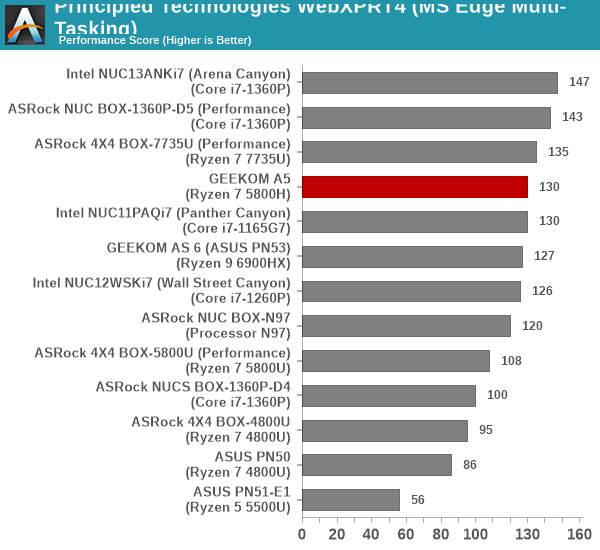
The A5 loses around half its performance in the presence of the transcoding task. However, the eight high-performance cores ensures that the system actually moves up in the raw scores front compared to the no-concurrent-loading scenario.
The final workload tested as part of the multitasking evaluation routine is CINEBENCH R23.
| 3D Rendering - CINEBENCH R23 Load Testing - Single Thread Score | |||
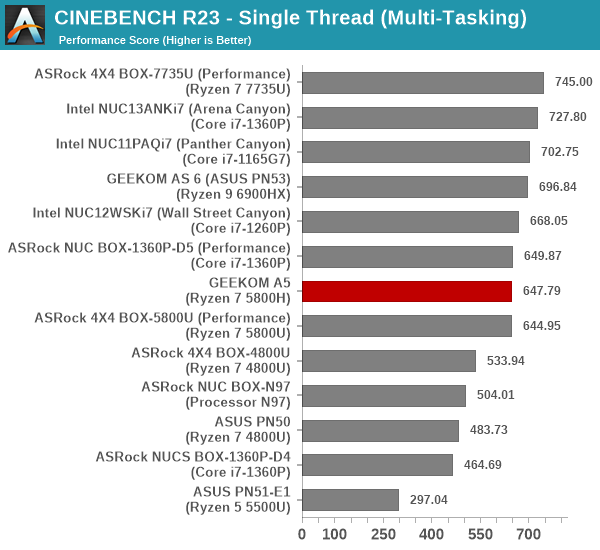
| 3D Rendering - CINEBENCH R23 Load Testing - Multiple Thread Score | |||
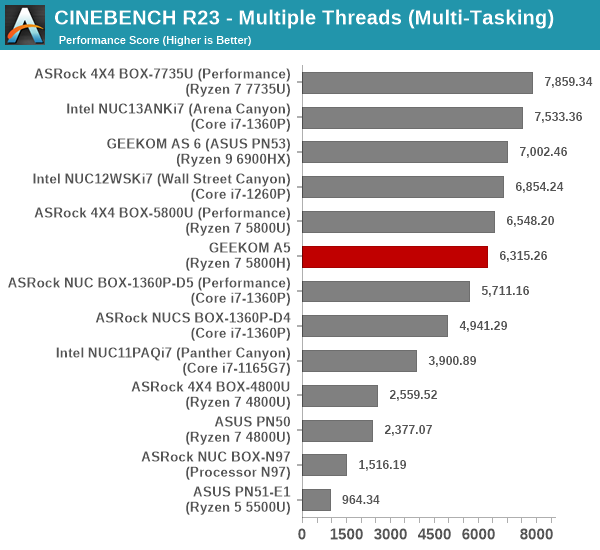
The performance loss in 3D rendering is around 50%, with the multi-threaded case being slightly less impacted. However, the relative ordering between the different systems doesn't change.
After the completion of all the workloads, we let the transcoding routine run to completion. The monitored transcoding rate throughout the above evaluation routine (in terms of frames per second) is graphed below.
| GEEKOM A5 (AMD Ryzen 7 5800H) ffmpeg Transcoding Rate (Multi-Tasking Test) | |||
| Task Segment | Transcoding Rate (FPS) | ||
| Minimum | Average | Maximum | |
| Transcode Start Pass | 3 | 12.83 | 43 |
| PCMark 10 | 0 | 11.28 | 38 |
| WebXPRT 4 | 3.5 | 11.8 | 21.5 |
| Cinebench R23 | 0 | 11.31 | 38.5 |
| Transcode End Pass | 2.5 | 12.71 | 39.5 |
The drop in transcoding frame rate is slightly higher for the AMD systems compared to the newer Intel systems with the thread director technology. The larger count of high-performance cores in the AMD systems helps alleviate some of the performance loss.


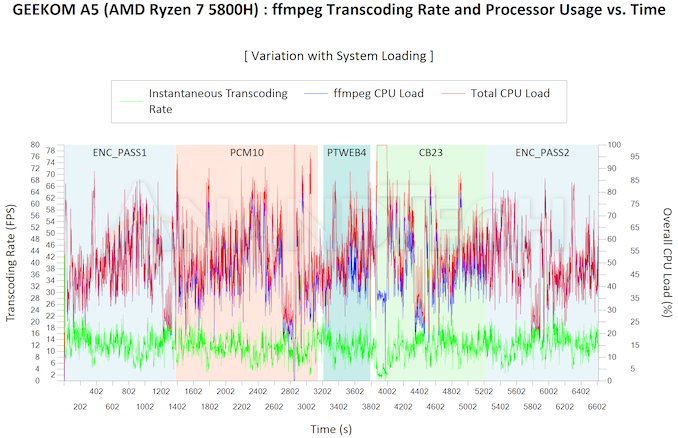








35 Comments
View All Comments
meacupla - Friday, December 8, 2023 - link
These miniPCs are getting ridiculously good at cost/performance.They are getting to the point where they should become the main thing OEMs should sell.
AIO, and proprietary mATX-but-not-exactly desktops should go extinct and be fully replaced with these.
ballsystemlord - Friday, December 8, 2023 - link
For checking email, sure this would work. But webbrowsers will happily eat 1GB of RAM per-webpage. I've said this for years. No one believed me until one day I happened to be using only 2 tabs and got a good screen shot of it in effect.So, for anything even somewhat serious, these mini-PCs will not do.
meacupla - Friday, December 8, 2023 - link
You would be so out of touch with reality if you think a 5800H with 32GB of RAM cannot handle more than email.Like this would handle massive excel spreadsheets and >4 youtube videos all at once.
ballsystemlord - Saturday, December 9, 2023 - link
Erm, the tested model was 16GB... No wait, it's 2x 16GB. I take that back.deil - Thursday, January 4, 2024 - link
Both pros and cons to this setup is size. as it's now, 64GB of ram is the limit, and usually you cannot get over 32GB from the shop, so you need to open it to get 64GB.It seems plenty for now, but as with small laptops, once you need more, you have no option.
single drive have same problem as well, as going bigger, usually costs more than double.
this is a resonable small pc for anyone who dont play AAA.
we are at place where 16GB is to small, but 32GB is still to pricy for normies.
pugster - Friday, December 8, 2023 - link
Depends on the processor. I have an mini pc with the 4800h cpu 32gb memory and 1tb of storage and it can easily watch 8 youtube videos without issues. I also have another mini pc with an intel n100 cpu which severly limits performance compared to amd.deil - Monday, December 11, 2023 - link
back in times, when they had atom cpu's they were horrible.right now when they run true laptop chips, they are just like mid-low tier laptops.
chip mentioned is top tier last year laptop.
if that is not enough then I have bad news, you need a $5000 threadripper, as desktop chips are about 130% of what this can to, tops.
cpu wise, they are 100% enough, gpu wise....
lets say new ones might be much better soon.
Samus - Saturday, December 9, 2023 - link
Meanwhile the average age on an office PC in the United States is 4 years and everyone seems to get along fine browsing the web on their 4-core Intel 10th gen's with 8GB RAM...iphonebestgamephone - Saturday, December 9, 2023 - link
I guess the browser pages you were on were some dual 8k vr porn or something.ballsystemlord - Saturday, December 9, 2023 - link
Actually, I don't watch porn... it was either a news site, tech site, or aliexpress.